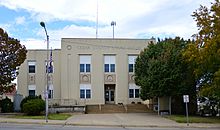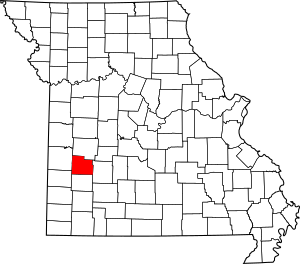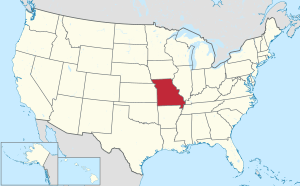Cedar County, Missouri facts for kids
Quick facts for kids
Cedar County
|
|
|---|---|

County courthouse in Stockton
|
|

Location within the U.S. state of Missouri
|
|
 Missouri's location within the U.S. |
|
| Country | |
| State | |
| Founded | February 14, 1845 |
| Named for | Cedar Creek, a tributary of the Sac River |
| Seat | Stockton |
| Largest city | El Dorado Springs |
| Area | |
| • Total | 499 sq mi (1,290 km2) |
| • Land | 474 sq mi (1,230 km2) |
| • Water | 24 sq mi (60 km2) 4.8% |
| Population
(2020)
|
|
| • Total | 14,188 |
| • Density | 28.433/sq mi (10.978/km2) |
| Time zone | UTC−6 (Central) |
| • Summer (DST) | UTC−5 (CDT) |
| Congressional district | 4th |
Cedar County is a place in the southwest part of Missouri, a state in the United States. In 2020, about 14,188 people lived here. The main town, or county seat, is Stockton. Cedar County started on February 14, 1845. It got its name from Cedar Creek, a stream that flows into the Sac River. This creek was named after the Eastern red cedar tree, which grows a lot in the area.
Contents
Exploring Cedar County's Land and Water
Cedar County covers a total area of about 499 square miles. Most of this is land, around 474 square miles. The rest, about 24 square miles, is water. This water includes different rivers and a big lake called Stockton Lake.
Neighboring Counties Around Cedar County
Cedar County shares its borders with several other counties.
- St. Clair County is to the north.
- Polk County is to the east.
- Dade County is to the south.
- Vernon County is to the west.
Main Roads and Highways in Cedar County
Several important roads help people travel through Cedar County.
People and Population in Cedar County
| Historical population | |||
|---|---|---|---|
| Census | Pop. | %± | |
| 1850 | 3,361 | — | |
| 1860 | 6,637 | 97.5% | |
| 1870 | 9,474 | 42.7% | |
| 1880 | 10,741 | 13.4% | |
| 1890 | 15,620 | 45.4% | |
| 1900 | 16,923 | 8.3% | |
| 1910 | 16,080 | −5.0% | |
| 1920 | 13,933 | −13.4% | |
| 1930 | 11,136 | −20.1% | |
| 1940 | 11,697 | 5.0% | |
| 1950 | 10,663 | −8.8% | |
| 1960 | 9,185 | −13.9% | |
| 1970 | 9,424 | 2.6% | |
| 1980 | 11,894 | 26.2% | |
| 1990 | 12,093 | 1.7% | |
| 2000 | 13,733 | 13.6% | |
| 2010 | 13,982 | 1.8% | |
| 2020 | 14,188 | 1.5% | |
| U.S. Decennial Census 1790-1960 1900-1990 1990-2000 2010-2020 |
|||
In 2000, about 13,733 people lived in Cedar County. There were 5,685 homes, with 3,894 of them being families. The county had about 29 people living per square mile. Most people living in the county were White (96.58%). A smaller number were Black, Native American, or Asian. About 1.11% of the people were of Hispanic or Latino background.
Many homes (57.50%) had married couples living together. About 27.80% of homes had children under 18. The average family size was about 2.86 people.
The population's age was spread out. About 24.60% were under 18 years old. About 20.80% were 65 years or older. The average age in the county was 42 years.
The average income for a household in 2000 was $26,694. For families, it was $32,710. About 17.40% of the people lived below the poverty line. This included 24.80% of children under 18.
Religious Beliefs in Cedar County
Cedar County is known for having many people who follow evangelical Protestantism. This area is part of what is sometimes called the "Bible Belt." The most common religious groups include Southern Baptists, Christian churches, and Assemblies of God.
2020 Census: Who Lives in Cedar County?
| Race | Num. | Perc. |
|---|---|---|
| White (NH) | 12,899 | 91% |
| Black or African American (NH) | 57 | 0.4% |
| Native American (NH) | 100 | 0.7% |
| Asian (NH) | 42 | 0.3% |
| Pacific Islander (NH) | 7 | 0.05% |
| Other/Mixed (NH) | 822 | 5.8% |
| Hispanic or Latino | 261 | 1.83% |
Learning and Schools in Cedar County
Cedar County has different schools for students to learn.
Public Schools for Everyone
There are two main public school districts in Cedar County.
- El Dorado Springs R-II School District in El Dorado Springs
- El Dorado Springs Elementary School (grades PK-5)
- El Dorado Springs Middle School (grades 6-8)
- El Dorado Springs High School (grades 9-12)
- Stockton R-I School District in Stockton
- Stockton Elementary School (grades PK-4)
- Stockton Middle School (grades 5-8)
- Stockton High School (grades 9-12)
Private Schools for Special Learning
Cedar County also has private schools.
- Agape Boarding School in Stockton (grades 1-12) is a school for boys with a Baptist background.
- El Dorado Christian School in El Dorado Springs (grades PK-12) is a school connected to the Church of God.
Public Libraries for Reading and Research
The Cedar County Library District helps everyone in the county access books and information.
Towns and Places in Cedar County
Cedar County has several towns and smaller communities.
Cities and Towns to Visit
- Caplinger Mills
- El Dorado Springs
- Jerico Springs
- Stockton (This is the main county seat!)
- Umber View Heights
Smaller Communities Without Their Own Government
Famous People From Cedar County
Some notable people have come from Cedar County.
- Kate Austin was a writer who supported women's rights and anarchism.
- Emil Liston was a basketball coach and administrator. He is even in the Basketball Hall of Fame!
- Eugene McCown was a talented jazz pianist and painter.
See also
 In Spanish: Condado de Cedar (Misuri) para niños
In Spanish: Condado de Cedar (Misuri) para niños

